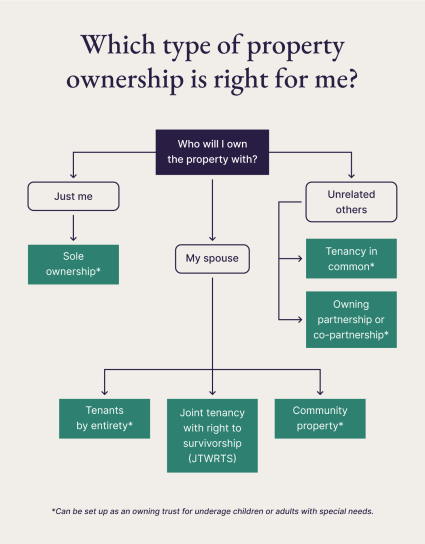
1. Sole ownership
Type of owner: individualsAs the name implies, sole ownership is when an individual is the only property owner. Since they are the only owner, they don’t require anyone’s consent to sell, lease or transfer the property to another person. Property owned by a sole owner is sent into probate when the owner dies until the will is validated.Pros:- You have complete control over all the decisions related to the property.
- The probate process can be costly and time-consuming, making transferring real estate to your heirs complicated during an already stressful and emotional time, especially if your heir cannot afford the property and needs to sell it.
2. Joint tenancy with rights of survivorship (JTWROS)
Type of owner: married couplesThe most common form of property ownership for married couples is joint tenancy with rights of survivorship, which awards both parties undivided ownership. Both parties have equal liability and financial responsibility for the property, including the cost of upkeep and repairs, as well as equal rights to access the property. In JTWROS, one owner may sell or transfer their portion of the property without the consent of the other owner. Pros:- When one owner dies, the property passes immediately to the remaining owner without going to probate.
- If one owner has unpaid debts, a creditor can legally force a sale to recoup their money.
- One party cannot will their share to another heir, such as a child.
3. Tenants by the entirety (TBE)
Type of owner: married couplesMarried couples may instead opt to own property as tenants by the entirety, which is the same as JTWROS, except an owner can do nothing with their ownership portion without consent from their spouse, since the couple is legally considered one entity. Divorce will automatically change the ownership agreement to tenants in common.Pros:- If one spouse is ordered to sell the property to pay off debt, the other spouse must be reimbursed their ownership interest.
- Only about half of all U.S. states, plus the District of Columbia, recognize TBE: Alaska, Arkansas, Delaware, Florida, Hawaii, Illinois, Indiana, Kentucky, Maryland, Massachusetts, Michigan, Mississippi, Missouri, New Jersey, New York, North Carolina, Ohio, Oklahoma, Oregon, Pennsylvania, Rhode Island, Tennessee, Vermont, Virginia and Wyoming
4. Community property
Type of owner: married couplesOnly 10 U.S. states are community property states. This real estate ownership type classifies any property obtained by a spouse during marriage as “community property” — that is, owned by both spouses, even if the property is only listed in the name of one spouse. This includes all real estate purchases made during the marriage. The states that recognize community property include Arizona, California, Idaho, Louisiana, Nevada, New Mexico, Texas, Washington and Wisconsin. In Alaska, residents can opt in to a community property agreement. The same community property laws apply to registered domestic partnerships in California, Nevada and Washington.Pros:- Both spouses have equal rights to the property and must consent to a sale or transfer of the property.
- This law makes any real estate obtained during marriage subject to sale by a debt collector to pay off a debt, even if the debt is only in one spouse’s name.
5. Owning trust
Type of owner: minor children or adult with disabilitiesAn owning trust entrusts the care and management of a property to a trustee acting on behalf of someone else, usually a child or an adult with special needs.A living trust is established while the original owner (also called a trustor or grantor) is still alive. The trustor names the beneficiary as the owner of the property, but until the trustor’s death, they also serve as the trustee. The property remains in the beneficiary’s name, but a new trustee is selected (usually named by the trust) to keep the property out of probate.Pros:- An owning trust allows your property to stay out of probate when you die while also protecting your home from creditors.
- Establishing an owning trust can be a complex and expensive process.
6. Tenancy in common (TIC)
Type of owner: unrelated multiple owners of a single propertyWhen owning property as a tenancy in common, each tenant has a separate deed for their presentation of the property. For example, four owners might divide ownership into four equal shares, or one owner may own half while the other three each own one-sixth of the property.Each tenant is allowed to sell, will or otherwise transfer their ownership share without the permission of the other owners since they lack survivorship rights. When a tenant dies, their ownership passes into probate before being transferred to any named heirs.Pros:- You can add owners at any time to minimize your portion of the mortgage, taxes and maintenance costs.
- A tenant can sell or will their share in the property to whomever they want, without the consent of the other tenants.
- If one tenant stops paying their portion of the mortgage and taxes, the other tenants in common are responsible for making up the difference.
7. Owning partnership/LLC or co-ownership
Type of owner: unrelated multiple owners of a single propertyProperties can be organized into a limited liability corporation (LLC) and multiple owners can purchase ownership shares in that LLC. This form of property co-ownership protects the owners and maintains more privacy than a tenancy in common since their personal finances are separated from the LLC. An owner can sell their share in the LLC without content from the other shareholders at any time.Owners can create the LLC by doing it themselves or use a third party co0 like Pacaso.Pros:- Properties owned by an LLC aren’t taxed directly, so you may see significant annual tax savings.
- LLCs allow you to own a property with other people like TIC, but with legal protection in the event of an accident on your property.
- Your name is not associated with the property, just the name of the LLC, making it more private than a traditional home purchase.
- Creating and maintaining an LLC requires contracts and other costs that can be overwhelming on your own.










